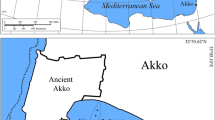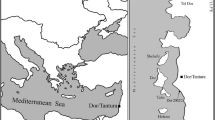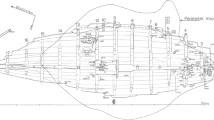Abstract
The Akko Tower Wreck is the remains of a 25-m-long merchant brig, which sank in Akko harbour during the second quarter of the nineteenth century. During underwater excavations, three iron-strapped deadeyes were retrieved from the shipwreck. Metallurgical investigation revealed information related to the manufacturing technologies of the objects. The presence of equiaxed grains combined with elongated inclusions indicates that the strops were made from indirect-smelted wrought iron manufactured by hot-forging and joined by riveting and forge welding. The welding zone of the loop was identified as a plain lap joint, and that of the chain links as a scarf joint. The high concentration of inclusions found on the forge-welding fracture surface may indicate the use of sand as the flux material. The composition, microstructure and manufacturing technology suggest that the deadeyes were manufactured during the second quarter of the nineteenth century, which supports the dating of the ship by other evidence.
















Similar content being viewed by others
References
A. Flinder, E. Linder, E.T. Hall, Survey of the ancient harbour of Akko, 1964–1966, in Studies in the Archaeology and History of Ancient Israel, ed. by M. Heltzer, A. Segal, D. Kaufman (Haifa University Press, Haifa, 1992), pp. 199–225
A. Raban, A shipwreck from Napoleon’s siege of Akko (1799), in Western Galilee Antiquities, ed. by M. Yedaya (Ministry of Defense, Tel Aviv (in Hebrew), 1986), pp. 195–208
J.R. Steffy, The Napoleonic wreck: a workshop in ship construction (Unpublished report) (1983)
D. Cvikel, The nineteenth-century Akko Tower Wreck, Israel: a summary of the first two excavation seasons. Int. J. Naut. Archaeol. 45(2), 406–422 (2016)
M. Cohen, D. Ashkenazi, A. Stern, Y. Kahanov, D. Cvikel, Iron artefacts from the Akko Tower Wreck, Israel, and their contribution to the ship’s characterization, Archaeo. Anthropo. Sci., Published online: 8 March 2016. doi: 10.1007/s12520-016-0320-5 (2016)
D. Sanders, Knowing the ropes: the need to record ropes and rigging on wreck-sites and some techniques for doing so. Int. J. Naut. Archaeol. 39(1), 2–26 (2010)
G. Biddlecombe, The Art of Rigging Containing an Explanation of Terms and Phrases, and the Progressive Method of Rigging Expressly Adapted for Sailing Ships. Charles Wilson, (London/Dover Publications, New York, 1848, reprinted 1990)
W. Falconer, An Universal Dictionary of the Marine, T. Cadell, London (1780, reprinted 1970)
P. Kemp, Oxford Companion to Ships and the Sea (Oxford University Press, London, 1976)
J. Lees, The Masting and Rigging of English Ships of War 1625–1860 (Naval Institute Press, Annapolis, 2007)
K.H. Marquardt, Eighteenth-Century Rig and Rigging (Conway, London, 2003). (reprint)
D. Steel, The Elements and Practice of Rigging and Seamanship (D. Steel, London, 1794)
R.C. Anderson, The Rigging of Ships: In the Days of the Spritsail Topmast, 1600–1720 (Dover Publications, New York, 2012). (reprint)
Z.W. Mondfeld, Historic Ship Models (Sterling Publishing, New York, 2005)
C. Pulak, The Padlocks, in Serçe Limanı: An Eleventh-Century Shipwreck Volume 1. The Ship and Its Anchorage, ed. by G.F. Bass, G.F. Matthews, J.R. Steffy (Crew and Passengers, College Station, TX, 2004), pp. 437–452
E. Blakelock, M. Martinon-Torres, H.A. Veldhuijzen, T. Young, Slag inclusions in iron objects and the quest for provenance: an experiment and a case study. J. Archaeol. Sci. 36(8), 1745–1757 (2009)
M. Cavallini, Thermodynamics applied to iron smelting techniques. Appl. Phys. A 113(4), 1049–1053 (2013)
J.L. Coze, Purification of iron and steels a continuous effort from 2000 BC to AD 2000. Mater. Trans. 41(1), 219–232 (2000)
M.L. Wayman, Archaeometallurgical contributions to a better understanding of the past. Mater. Charact. 45(4), 259–267 (2000)
V.F. Buchwald, H. Wivel, Slag analysis as a method for the characterization and provenancing of ancient iron objects. Mater. Charact. 40(2), 73–96 (1998)
V. Geantă, R. Stefănoiu, The Engineering of Steel Production (Bren, Bucharest, 2008)
E. Tomàs, The Catalan process for the direct production of malleable iron and its spread to Europe and the Americas. Contrib. Sci. 1(2), 225–232 (1999)
R.F. Tylecote, A History of Metallurgy, 2nd edn. (The Metals Society, London, 1992)
P. Belford, Hot blast iron smelting in the early nineteenth century: a re-appraisal. Hist. Metall. 46(1), 32–44 (2012)
D. Cvikel, D. Ashkenazi, A. Stern, Y. Kahanov, Characterization of a 12-pdr wrought-iron cannonball from the Akko 1 shipwreck. Mater. Charact. 83, 198–211 (2013)
N. North, M. Owens, C. Pearson, Thermal stability of cast and wrought marine iron. Stud. Conserv. 21(4), 192–197 (1976)
A. Aronson, D. Ashkenazi, O. Barkai, Y. Kahanov, Archaeometallurgical investigation of the iron anchor from the Tantura F shipwreck. Mater. Charact. 78, 108–120 (2013)
M. Eliyahu, O. Barkai, Y. Goren, N. Eliaz, Y. Kahanov, D. Ashkenazi, The iron anchors from the Tantura F shipwreck: typological and metallurgical analyses. J. Archaeol. Sci. 38(2), 233–245 (2011)
Q. Collette, S. Sire, W.J. Vermes, V.J. Mesler, I. Wouters, Experimental investigations on hot-driven structural rivets in historical French and Belgian wrought-iron structures. Constr. Build. Mater. 54, 258–269 (2014)
P.T. Houldcroft, Welding process developments and future trends. Mater. Des. 7(4), 162–169 (1986)
R.F. Tylecote, The Solid Phase Welding of Metals (Edward Arnold, London, 1968)
D. Ashkenazi, D. Cvikel, M. Holtzman, D. Bershadski, A. Stern, S. Klein Y. Kahanov, The Dor C shipwreck, Israel: metallurgical analysis and its contribution to the ship characterization. Archaeo. Anthropo. Sci., Published online: 10 October 2015. (2015). doi: 10.1007/s12520-015-0296-6
R.-F. Stanescu, A single pass butt-welded pipe finite element method computer simulation. Unpublished Ph.D. dissertation, Carleton University, Ottawa (2005)
H.J. McQueen, Pressure welding, solid state: role of hot deformation. Can. Metall. Q. 51(3), 239–249 (2012)
Å. Öberg, N. Mårtensson, J.Å. Schweitz, Fundamental aspects of formation and stability of explosive welds. Metall. Trans. A 16(5), 841–852 (1985)
D. Ashkenazi, D. Cvikel, A. Stern, A. Pasternak, O. Barkai, A. Aronson, K. Kahanov, Archaeometallurgical investigation of joining processes of metal objects from shipwrecks: three test cases. Metallogr. Microstruct. Anal. 3(5), 349–362 (2014)
T. Lienert, T. Siewert, S. Babu, V. Acoff (eds.), Welding Fundamentals and Processes, ASM Handbook, vol. 6A (ASM International, OH, 2011)
A. Stern, V. Shribman, A. Ben-Artzy, M. Aizenshtein, Interface phenomena and bonding mechanism in magnetic pulse welding. J. Mater. Eng. Perform. 23(10), 3449–3458 (2014)
S. Mahabunphachai, M. Koc, J. Ni. Characterization of pressure welding process of thin sheet metals in cold and warm temperature conditions. In ASME 2007 International Manufacturing Science and Engineering Conference (American Society of Mechanical Engineers, Atlanta, 2007), pp. 227–233
H.J. McQueen, Successful transition from wrought iron to steel in hot work processing with mechanism differences. Mater. Sci. Forum 638–642, 3380–3387 (2010)
J.D. Light, Observations concerning the hand forging of wrought iron. Mater. Charact. 45, 327–340 (2000)
H.A. Mohamed, J. Washburn, Mechanisms of solid state pressure welding. Weld. J. Res. Suppl. 54, 302s–310s (1975)
A. Stern, D. Ashkenazi, D. Cvikel, B. Rosen, E. Galili, Archeometallurgical and technical characterization of seventh century AD iron fishing-spear and fire basket found in the Dor lagoon, Israel. J. Archaeol. Sci. Rep. 3, 132–143 (2015)
N.C. Ciarlo, H. De Rosa, D. Elkin, H. Svoboda, C. Vázquez, D. Vainstub, L. Diaz, Perdiguero, examination of an 18th century English anchor from Puerto Deseado (Santa Cruz Province, Argentina). Hist. Metall. 45(1), 71–79 (2011)
M. Giles, Making metal and forging relations: ironworking in the British iron age. Oxf. J. Archaeol. 26(4), 395–413 (2007)
R.E.M. Hedges, C.J. Salter, Source determination of iron currency bars through analysis of the slag inclusions. Archaeometry 21(2), 161–175 (1979)
L. Engel, H. Klingele, An Atlas of Metal Damage, Surface Examination by Scanning Electron Microscope (Wolfe Publishing, Arizona, 1981)
J.G. Adelantado, M.F. Ferrer, F.V. Algarra, J.P. Vicente, F.B. Reig, Analytical study by SEM/EDX and metallographic techniques of materials used in the iron production process during the Iberian period. Talanta 60(5), 895–910 (2003)
Acknowledgements
The underwater excavations (IAA excavation permits G-23/2012, G-78/2013, G-16/2015 and G-25/2016) and research of the Akko Tower Wreck are supported by the Israel Science Foundation (Grant No. 447/12), the Honor Frost Foundation, D. Shafir, a Sir Maurice Hatter Fellowship, and the Rector and Research Authority of the University of Haifa, to whom the authors are grateful. The authors are grateful to Y. Shoef, Gabi Shoef Ltd, for the RT assistance; to V. Marinescu from ICPE-CA Bucharest for his valuable SEM assistance; to J. Tresman for the English editing; and to the anonymous reviewers for their valuable comments and suggestions.
Author information
Authors and Affiliations
Corresponding author
Rights and permissions
About this article
Cite this article
Voiculescu, I., Geantă, V., Stern, A. et al. Iron-Bound Deadeyes from the Nineteenth-Century Akko Tower Wreck, Israel: Metallurgical Investigation of the Manufacturing Technology. Metallogr. Microstruct. Anal. 6, 106–125 (2017). https://doi.org/10.1007/s13632-017-0342-0
Received:
Revised:
Accepted:
Published:
Issue Date:
DOI: https://doi.org/10.1007/s13632-017-0342-0




